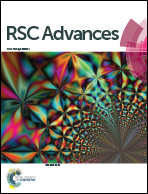Ultrafine porous boron nitride nanofibers synthesized via a freeze-drying and pyrolysis process and their adsorption properties†
Abstract
One-dimensional (1D) boron nitride (BN) nanostructures with a high aspect ratio are of prime interest due to their importance in fundamental research and wide-range potential applications. Herein we developed a facile method for the first synthesis of ultrafine porous BN nanofibers in high purity and a high yield. The method included two-steps, freeze-drying of a hot melamine/boric acid solution and post pyrolysis of the as-obtained products. The extremely rapid cooling of the hot melamine/boric acid solution during the freeze-drying process resulted in the formation of ultrafine precursors, which was the key for the final synthesis of porous BN nanofibers with downsized diameters (20–60 nm) and high aspect ratios. The as-synthesized ultrafine BN nanofibers possessed a high specific surface area and a large pore volume, which could be tuned by the pyrolysis parameters. All of these characteristics make the porous BN nanofibers promising in the applications of water treatment, hydrogen storage, catalyst support, etc. Especially, ultrafast adsorption of methylene blue (MB) in water has been demonstrated using the present porous BN nanofibers as an adsorbent.


 Please wait while we load your content...
Please wait while we load your content...